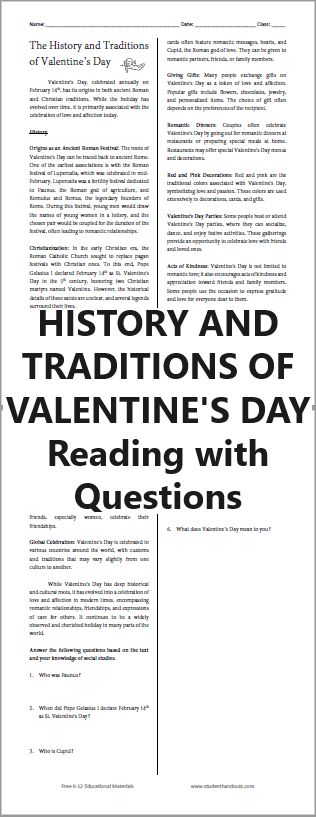| History and Customs of Valentine's Day Worksheet |
|---|
| www.studenthandouts.com ↣ Fun Stuff ↣ Holiday Activities and Worksheets ↣ Valentine's Day |
|
Valentine's Day, celebrated annually on February 14th, has its origins in both ancient Roman and Christian traditions. While the holiday has evolved over time, it is primarily associated with the celebration of love and affection today. History Origins as an Ancient Roman Festival: The roots of Valentine's Day can be traced back to ancient Rome. One of the earliest associations is with the Roman festival of Lupercalia, which was celebrated in mid-February. Lupercalia was a fertility festival dedicated to Faunus, the Roman god of agriculture, and Romulus and Remus, the legendary founders of Rome. During this festival, young men would draw the names of young women in a lottery, and the chosen pair would be coupled for the duration of the festival, often leading to romantic relationships.  Christianization: In the early Christian era, the Roman Catholic Church sought to replace pagan festivals with Christian ones. To this end, Pope Gelasius I declared February 14th as St. Valentine's Day in the 5th century, honoring two Christian martyrs named Valentine. However, the historical details of these saints are unclear, and several legends surround their lives.
Christianization: In the early Christian era, the Roman Catholic Church sought to replace pagan festivals with Christian ones. To this end, Pope Gelasius I declared February 14th as St. Valentine's Day in the 5th century, honoring two Christian martyrs named Valentine. However, the historical details of these saints are unclear, and several legends surround their lives.Customs and Traditions Exchange of Love Notes: One of the most common customs associated with Valentine's Day is the exchange of love notes, known as "valentines." These cards often feature romantic messages, hearts, and Cupid, the Roman god of love. They can be given to romantic partners, friends, or family members. Giving Gifts: Many people exchange gifts on Valentine's Day as a token of love and affection. Popular gifts include flowers, chocolates, jewelry, and personalized items. The choice of gift often depends on the preferences of the recipient. Romantic Dinners: Couples often celebrate Valentine's Day by going out for romantic dinners at restaurants or preparing special meals at home. Restaurants may offer special Valentine's Day menus and decorations. Red and Pink Decorations: Red and pink are the traditional colors associated with Valentine's Day, symbolizing love and passion. These colors are used extensively in decorations, cards, and gifts. Valentine's Day Parties: Some people host or attend Valentine's Day parties, where they can socialize, dance, and enjoy festive activities. These gatherings provide an opportunity to celebrate love with friends and loved ones. Acts of Kindness: Valentine's Day is not limited to romantic love; it also encourages acts of kindness and appreciation toward friends and family members. Some people use the occasion to express gratitude and love for everyone dear to them. Proposal Day: Valentine's Day is a popular day for marriage proposals. It is seen as a romantic and memorable day to ask for someone's hand in marriage. Charitable Acts: Some individuals and organizations use Valentine's Day as an opportunity to engage in charitable activities, such as distributing gifts to the less fortunate or volunteering in their communities. Celebration of Friendship: In addition to romantic love, Valentine's Day has evolved to include the celebration of friendship. This has led to the popularization of the term "Galentine's Day," where friends, especially women, celebrate their friendships. Global Celebration: Valentine's Day is celebrated in various countries around the world, with customs and traditions that may vary slightly from one culture to another. While Valentine's Day has deep historical and cultural roots, it has evolved into a celebration of love and affection in modern times, encompassing romantic relationships, friendships, and expressions of care for others. It continues to be a widely observed and cherished holiday in many parts of the world. Answer the following questions based on the text and your knowledge of social studies.
|
 |  |  |  |  |  |
| www.studenthandouts.com ↣ Fun Stuff ↣ Holiday Activities and Worksheets ↣ Valentine's Day |








